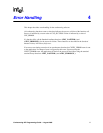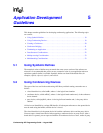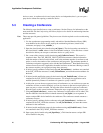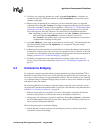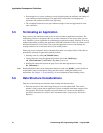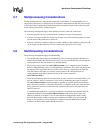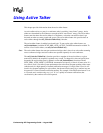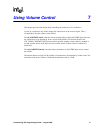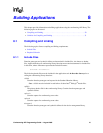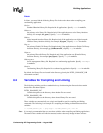
Conferencing API Programming Guide — August 2006 25
6
6.Using Active Talker
This chapter provides information about the active talker feature.
An active talker refers to a party in a conference who is providing “non-silence” energy. Active
talkers are determined by the loudness or strength of their “non-silence” energy. The active talker
feature sums the three most active talkers in a conference, so that the conversation doesn’t get
drowned out when too many people talk at once. The active talker feature also provides data on
active talkers through the cnf_GetActiveTalkerList( ) function.
The active talker feature is enabled on a board basis. To turn on the active talker feature, use
cnf_SetAttributes( ) with the ECNF_BRD_ATTR_ACTIVE_TALKER enumeration enabled. To
retrieve a list of active talkers, use cnf_GetActiveTalkerList( ).
Note: The active talker feature does not span conference bridges; that is, there is no active talker summing
across conference bridges and active talkers are reported separately for each conference.
The cnf_GetActiveTalkerList( ) function provides a snapshot of the active talkers at a given
moment. By default, the snapshot is updated every second. To change this value and specify how
frequently the active talker status is updated, use the cnf_SetAttributes( ) function with the
ECNF_BRD_ATTR_NOTIFY_INTERVAL enumeration and specify a value in 10 msec units. If a
low value is used, it can affect system performance due to the more frequent updating of the status
(which results in a high quantity of internal notification messages). If a high value is used, it will
result in less frequent updating on active talkers, but the non-silence energy by a conferee may not
be reported if it occurs between notification updates. For example, if the notification interval is set
to 2 seconds and a conferee only says “yes” or “no” quickly in between notifications, that
vocalization by the conferee will not be reported.



